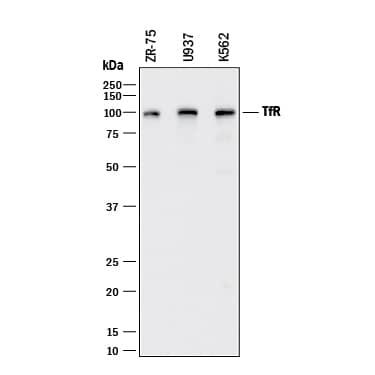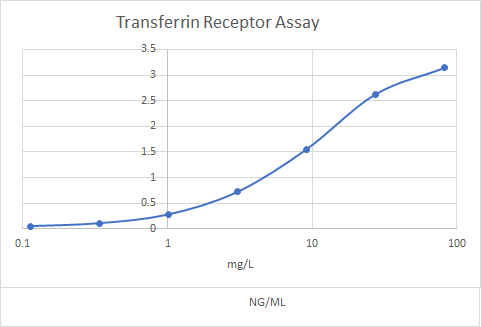Human TfR (Transferrin R) Antibody Summary
Applications
Please Note: Optimal dilutions should be determined by each laboratory for each application. General Protocols are available in the Technical Information section on our website.
Scientific Data
 View Larger
View Larger
Detection of Human TfR (Transferrin R) by Western Blot. Western blot shows lysates of ZR-75 human breast cancer cell line, U937 human histiocytic lymphoma cell line, and K562 human chronic myelogenous leukemia cell line. PVDF membrane was probed with 0.25 µg/mL of Goat Anti-Human TfR (Transferrin R) Antigen Affinity-purified Polyclonal Antibody (Catalog # AF2474) followed by HRP-conjugated Anti-Goat IgG Secondary Antibody (Catalog # HAF017). A specific band was detected for TfR (Transferrin R) at approximately 95 kDa (as indicated). This experiment was conducted under reducing conditions and using Immunoblot Buffer Group 1.
 View Larger
View Larger
TfR (Transferrin R) in Human Liver. TfR (Transferrin R) was detected in immersion fixed paraffin-embedded sections of human liver using Goat Anti-Human TfR (Transferrin R) Antigen Affinity-purified Polyclonal Antibody (Catalog # AF2474) at 5 µg/mL overnight at 4 °C. Tissue was stained using the Anti-Goat HRP-DAB Cell & Tissue Staining Kit (brown; Catalog # CTS008) and counterstained with hematoxylin (blue). Specific labeling was localized to the plasma membrane of hepatocytes. View our protocol for Chromogenic IHC Staining of Paraffin-embedded Tissue Sections.
 View Larger
View Larger
Detection of Mouse TfR (Transferrin R) by Western Blot Effect of Pcsk9 deletion on LDLR and CD81 levels in age- and sex-matched Pcsk9-/- mice (n = 5) and their wild type littermates (n = 4).Shown are (A) mean ± SE serum LDL-C levels and (B) Western blot analysis of CD81 and LDLR levels in liver extracts with TfR as loading control, in animals sacrificed after a 4-hour fast. Lanes in panel B represent samples from individual mice. LDL-C, low-density lipoprotein cholesterol; LDLR, low-density lipoprotein receptor; PCSK9, proprotein convertase subtilisin/kexin type 9; SE, standard error; TfR, transferrin receptor; wt, wild type. Image collected and cropped by CiteAb from the following publication (https://dx.plos.org/10.1371/journal.pone.0154498), licensed under a CC-BY license. Not internally tested by R&D Systems.
Reconstitution Calculator
Preparation and Storage
- 12 months from date of receipt, -20 to -70 °C as supplied.
- 1 month, 2 to 8 °C under sterile conditions after reconstitution.
- 6 months, -20 to -70 °C under sterile conditions after reconstitution.
Background: TfR (Transferrin R)
The Transferrin Receptor (TfR or TfR-1, designated CD71) is a type 2 transmembrane glycoprotein expressed on erythroid progenitors, muscle cells and proliferating cells as a 188 kDa disulfide-linked homodimer of 95 kDa monomers (1-4). As the major mediator of cellular iron uptake, it binds and internalizes diferric transferrin, allowing iron release at the low pH of the endosome (2, 5). The human TfR cDNA encodes 760 amino acids (aa) including a 67 aa N-terminal intracellular domain, a 21 aa transmembrane domain, and a 672 aa extracellular domain (ECD) with helical, peptidase (nonfunctional), and ligand binding domains, including an RGD potential integrin binding site (5). Human TfR ECD shares 75 - 80% aa identity with mouse, rat, feline, canine, equine, porcine and bovine TfR. A 679 aa alternately spliced form begins at aa 82 and is presumably secreted, while in an 804 aa form, 44 aa are inserted at aa 518 within the peptidase region (6). Most soluble TfR (sTfR) arises from trypsin proteolysis at aa 100, producing the circulating form of TfR (3). sTfR concentration in plasma or serum is proportional to total TfR and can be increased by iron deficiency (3). Erythroid progenitors, which use iron for hemoglobin synthesis, normally account for the bulk of total body TfR production (3). Since rapidly growing cells require iron to replicate DNA, cancer cells can express up to 5-fold more TfR than quiescent cells in the surrounding tissue (2, 4). Antibody targeting of TfR can inhibit tumor cell proliferation and induce apoptosis (2, 4). The hereditary hemochromatosis protein HFE competes with diferric transferrin for binding to TfR, and targets TfR for degradation rather than recycling (2, 5). TfR has been reported to have ferritin-independent functions in T cell development, immunological synapse formation and galectin-3-mediated cell death, and to be a cell entry receptor for New World hemorrhagic fever arenaviruses (2, 4, 7).
- Schneider, C. et al. (1984) Nature 311:675.
- Daniels, T.R. et al. (2006) Clin. Immunol. 121:144.
- Skikne, B.S. (2008) Am. J. Hematol. 83:872.
- Macedo, M.F. and M. deSousa (2008) Inflamm. Allergy Drug Targets 7:41.
- Aisen, P. (2004) Int. J. Biochem. Cell Biol. 36:2137.
- Entrez protein Accession # EAW53671, EAW53672.
- Radoshitzky, S.R. et al. (2007) Nature 446:92.
Product Datasheets
Citations for Human TfR (Transferrin R) Antibody
R&D Systems personnel manually curate a database that contains references using R&D Systems products. The data collected includes not only links to publications in PubMed, but also provides information about sample types, species, and experimental conditions.
13
Citations: Showing 1 - 10
Filter your results:
Filter by:
-
Activation of cell-surface proteases promotes necroptosis, inflammation and cell migration
Authors: Zhenyu Cai, Anling Zhang, Swati Choksi, Weihua Li, Tao Li, Xue-Min Zhang et al.
Cell Research
-
Modeling Secondary Iron Overload Cardiomyopathy with Human Induced Pluripotent Stem Cell-Derived Cardiomyocytes
Authors: JW Rhee, H Yi, D Thomas, CK Lam, N Belbachir, L Tian, X Qin, J Malisa, E Lau, DT Paik, Y Kim, BS Choi, N Sayed, K Sallam, R Liao, JC Wu
Cell Rep, 2020-07-14;32(2):107886.
-
A transferrin-target magnetic/fluorescent dual-mode probe significantly enhances the diagnosis of non-small cell lung cancer
Authors: Jiali Cai, Bingxin Gu, Fengwen Cao, Shiyuan Liu
Oncotarget
-
Molecular mechanisms of non-transferrin-bound and transferring-bound iron uptake in primary hippocampal neurons
Authors: Changyi Ji, Daniel J. Kosman
Journal of Neurochemistry
-
The iron chelator, PBT434, modulates transcellular iron trafficking in brain microvascular endothelial cells
Authors: DK Bailey, W Clark, DJ Kosman
PLoS ONE, 2021-07-26;16(7):e0254794.
Species: Human
Sample Types: Cell Lysates
Applications: Western Blot -
Nonclinical safety evaluation of pabinafusp alfa, an anti-human transferrin receptor antibody and iduronate-2-sulfatase fusion protein, for the treatment of neuronopathic mucopolysaccharidosis type II
Authors: R Yamamoto, E Yoden, N Tanaka, M Kinoshita, A Imakiire, T Hirato, K Minami
Molecular genetics and metabolism reports, 2021-04-18;27(0):100758.
Species: Human
Sample Types: Recombinant Protein
Applications: Surface Plasmon Resonance -
Receptor tyrosine kinase inhibitor Sunitinib and integrin antagonist peptide HM-3 show similar lipid raft dependent biphasic regulation of tumor angiogenesis and metastasis
Authors: J Hu, W Wang, C Liu, M Li, E Nice, H Xu
J. Exp. Clin. Cancer Res., 2019-08-28;38(1):381.
Species: Human
Sample Types: Cell Lysates
Applications: Western Blot -
Manganese Uptake by A549 Cells is Mediated by Both ZIP8 and ZIP14
Authors: IF Scheiber, NO Alarcon, N Zhao
Nutrients, 2019-06-28;11(7):.
Species: Human
Sample Types: Cell Lysates
Applications: Western Blot -
IFITM3 directly engages and shuttles incoming virus particles to lysosomes
Authors: JS Spence, R He, HH Hoffmann, T Das, E Thinon, CM Rice, T Peng, K Chandran, HC Hang
Nat. Chem. Biol., 2019-01-14;0(0):.
Species: Human
Sample Types: Cell Lysates
Applications: Western Blot -
Alirocumab, a Therapeutic Human Antibody to PCSK9, Does Not Affect CD81 Levels or Hepatitis C Virus Entry and Replication into Hepatocytes
PLoS ONE, 2016-04-26;11(4):e0154498.
Species: Mouse
Sample Types: Serum
Applications: Western Blot -
Systemic combinatorial peptide selection yields a non-canonical iron-mimicry mechanism for targeting tumors in a mouse model of human glioblastoma.
Authors: Staquicini FI, Ozawa MG, Moya CA, Driessen WH, Barbu EM, Nishimori H, Soghomonyan S, Flores LG, Liang X, Paolillo V, Alauddin MM, Basilion JP, Furnari FB, Bogler O, Lang FF, Aldape KD, Fuller GN, Höök M, Gelovani JG, Sidman RL, Cavenee WK, Pasqualini R, Arap W
J. Clin. Invest., 2010-12-22;121(1):161-73.
Species: Human
Sample Types: Whole Tissue
Applications: IHC-Fr -
Targeting ADAM10 to lipid rafts in neuroblastoma SH-SY5Y cells impairs amyloidogenic processing of the amyloid precursor protein.
Authors: Harris B, Pereira I, Parkin E
Brain Res., 2009-08-11;1296(0):203-15.
Species: Human
Sample Types: Cell Lysates
Applications: Western Blot -
PCSK9 Modulates the Secretion But Not the Cellular Uptake of Lipoprotein(a) Ex Vivo: An Effect Blunted by Alirocumab
Authors: Elise F. Villard, Aurélie Thedrez, Jorg Blankenstein, Mikaël Croyal, Thi-Thu-Trang Tran, Bruno Poirier et al.
JACC: Basic to Translational Science
FAQs
No product specific FAQs exist for this product, however you may
View all Antibody FAQsReviews for Human TfR (Transferrin R) Antibody
Average Rating: 4 (Based on 2 Reviews)
Have you used Human TfR (Transferrin R) Antibody?
Submit a review and receive an Amazon gift card.
$25/€18/£15/$25CAN/¥75 Yuan/¥2500 Yen for a review with an image
$10/€7/£6/$10 CAD/¥70 Yuan/¥1110 Yen for a review without an image
Filter by:
Coated wells with this antibody to measure transferrin receptor in an immunoassay.
Total cell lysates from HeLa, PC-3, MCF-7 and MDA-MB-231 were subjected to western blot. PVDF membrane were probed with 0.5 um/ml Human TfR Antibody (AF2474). A specific band was detected for TfR at approximately 90 kDa. This experiment was conducted under reducing conditions



